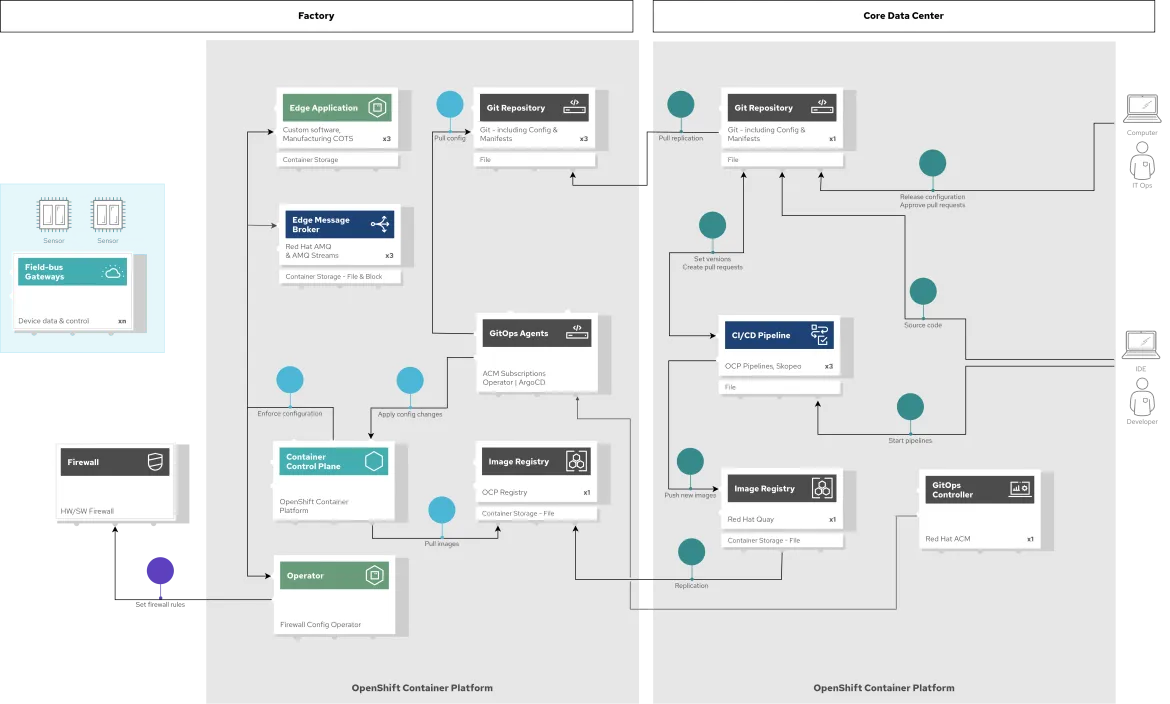The manufacturing industry has consistently used technology to fuel innovation, production optimization and operations. Now, with the combination of edge computing and AI/ML, manufacturers can benefit from bringing processing power closer to data that, when put into action faster, can help to proactively discover of potential errors at the assembly line, help improve product quality, and even reduce potential downtime through predictive maintenance and in the unlikely event of a drop in communications with a central/core site, individual manufacturing plants can continue to operate.
But this revolution of process and data requires many complex systems: sensors, line servers, wireless gateways, operational dashboards, servers and tablets for the maintenance teams on the floor to monitor the whole system. Unlike the factory systems of the past that were custom built and managed by operations technology (OT), the desired approach to support use cases that not only collect, analyze and act on machine, plant, and factory floor data in real time is to do so in a standardized manner.
To achieve this manufacturing vision, along with the continued digitalization of factories, manufacturers must now take a hard look at their operations and technology to meet these new opportunities. It requires factory systems to mirror the best practices of a modern IT environment based on containers, Kubernetes, agile development, AI/ML and automation. All of these technologies, coincidentally, are components of open hybrid cloud, an IT footprint that can be used to accommodate these manufacturing technologies, from the edge of the network to the factory floor.
What does it take? Let’s break it down
Let’s examine a manufacturing use case that needs to capture sensor information from line servers and route it to the on-site factory cluster where data can be analyzed in real-time with AI/ML models. This data can then be sent to the centralized data center or cloud for further processing and storage. We’ll cover how within this use case, what is done in a single plant/location, can scale to multiple sites with consistency to meet the needs of modern manufacturing organizations including:
-
A production model: manage the complexity and relationships of manufacturing “silos” and links in the supply chain.
-
Real-time processing and analysis of data: ability to monitor orders, materials, machine status, shipments.
-
Failure prediction (predictive maintenance): anticipate and act on production line events before they occur.
-
Security: conformance to corporate and government IT security policies.
-
Compliance: auditing of factory and core data center systems using operational and historical record keeping.
-
Modularity: transition from monolithic production systems to microservices.
-
Factory modernization: IT systems that can adapt to factory production line changes.
-
Safety: workers and equipment can be monitored continuously and many issues can be detected much earlier.
Meeting the needs of consistency and intelligence at the edge
In order to meet the needs of modern manufacturing organizations, it's important to acknowledge that manufacturing customers are under tremendous pressure to drive innovation and efficiency on their plant floors. This requires a holistic approach that incorporates a combination of modern IT products and emerging methodologies with the goal being to avoid the tedious and error-prone manual configuration of different systems and applications at scale.
Among the top considerations for building the edge architecture for this one manufacturing plant is that it needs to be scalable to hundreds of factories, without needing much manual intervention and increase in resources to manage them.
In addition, it needs sophisticated data messaging between potentially disconnected systems, robust storage for data from the factory line servers to the corporate data lake and integrated machine learning (ML) components and pipelines for delivering factory automation intelligence. Also, the hardware footprint for manufacturing systems can vary dramatically from low power, low memory units for data collection on the factory floor, all the way up to multi-core, large memory nodes in a central data center.
Two fundamental strategies that can help achieve this are:
-
GitOps and blueprints
-
AI/ML
GitOps and Blueprints
GitOps is a paradigm whereby enterprises use git as the declarative source of truth for the continuous deployment (CD) of system updates. Administrators can carefully and efficiently manage system complexity by pushing reviewed commit changes of configuration settings and artifacts to git, where they are then automatically pushed into operational systems. The idea is that the current state of complex distributed systems can be reflected within git as code.
In Kubernetes, GitOps is a powerful abstraction since it mirrors the underlying design goals of that platform: a Kubernetes cluster is always reconciling to a point of truth with respect to what developers and administrators have declared should be the target state of the cluster. An ideal GitOps model for Kubernetes employs a pipeline approach where YAML-based configuration and container image changes can originate as git commits that then trigger activities in the pipeline that result in updates to applications and indeed the cluster itself. Below is a graphical representation of a GitOps flow:

So for manufacturing environments, we can see the utility of something like GitOps for a consistent, declarative approach to managing individual cluster changes and upgrades. But we also know that edge manufacturing environments are heterogeneous in their size and type of hardware resources.
This is where the concept of blueprints comes in: declarative specifications that can be organized in layers such that infrastructure settings that can be shared are shared, but also allow for various points of customization where it is required. Blueprints are used to define all the components used within an edge reference architecture such as hardware, software, management tools, and point of delivery (PoD) tooling.
AI/ML to turn insights into action
Given that this use case involves the generation of large amounts of sensor data, we need to turn to AI/ML capabilities to produce actionable insights from that data. Human operators need to be able to view HMI/SCADA (Human Machine Interface/Supervisory control and data acquisition) dashboards in the factory of not only the real-time status of production lines, but also be presented with predictive information of factory health. The data from the line servers serves two purposes for AI/ML:
-
To drive the development, testing and deployment of machine learning models for predictive maintenance
-
To provide live data streams into those deployed models for inference at the factory
The below diagram depicts a sample AI/ML workflow:

Addressing industrial manufacturing use cases with Red Hat
Red Hat provides a technology advantage for manufacturers today with a portfolio of building blocks organized around Red Hat OpenShift, the industry’s most comprehensive enterprise Kubernetes platform. Red Hat products can be deployed and managed as scalable infrastructure for manufacturing use cases in an automated and repeatable way, and also coordinate the data messaging, storage, and machine learning (ML) pipeline.
Using a modular approach to building the edge architecture (see below) provides the flexibility to deploy any of the components shown where it makes sense — from the core data center to the factory floor, to address the needs of various manufacturing use cases.

What’s also important is having a reliable message queue that can hand off data to a scalable storage system as part of an open hybrid cloud model. Such a system manages the flow of data from the sensors all the way to the long term storage systems. Here is a breakdown of how the Red Hat portfolio works together to address the needs of our manufacturing use case:
-
OpenShift provides the robust, holistically secure and scalable enterprise container platform.
-
Data coming from sensors is transmitted over MQTT to Red Hat AMQ, which routes sensor data for two purposes: model development in the core data center and live inferencing in the factory data centers. The data is then relayed on to Red Hat AMQ Streams (Kafka) for further distribution within the factory datacenter and out to the core data center.
-
The lightweight Apache Camel K provides MQTT (Message Queuing Telemetry Transport) integration that normalizes and routes sensor data to the other components.
-
That sensor data is mirrored into a data lake that is provided by Red Hat Open Container Storage. Data scientists then use various tools from the open source project Open Data Hub to perform model development and training, pulling and analyzing content from the data lake into notebooks where they can apply ML frameworks.
-
Once the models have been tuned and are deemed ready for production, the artifacts are committed to git which kicks off an image build of the model using OpenShift Pipelines (Tekton).
-
The model image is pushed into the integrated registry of OpenShift running in the core data center which is pushed back down to the factory data center for use in inferencing.
In addition, Red Hat’s partner ecosystem is strategic to solving these use cases. The Seldon Core open source platform for deploying machine learning models is used in this solution to provide the cloud-native model wrapping, deployment, and serving.
Putting it all together
Building on top of the open source, highly customizable Kubernetes-based Red Hat OpenShift platform can prepare your technology stacks for the future. And when used in combination with the various elements of Red Hat’s software portfolio, you can benefit from a powerful foundation for building out a true AI/ML driven, edge-based manufacturing process, complete with sensors and the open hybrid cloud behind it all.
To learn more about Red Hat’s edge computing approach, visit our article on why Red Hat for edge computing.
Sugli autori
Frank Zdarsky is Senior Principal Software Engineer in Red Hat’s Office of the CTO responsible for Edge Computing. He is also a member of Red Hat’s Edge Computing leadership team. Zdarsky’s team of seasoned engineers is developing advanced Edge Computing technologies, working closely with Red Hat’s business, engineering, and field teams as well as contributing to related open source community projects. He is serving on the Linux Foundation Edge’s technical advisory council and is a TSC member of the Akraino project.
Prior to this, Zdarsky was leading telco/NFV technology in the Office of the CTO and built a forward deployed engineering team working with Red Hat’s most strategic partners and customers on enabling OpenStack and Kubernetes for telco/NFV use cases. He has also been an active contributor to open source projects such as OpenStack, OpenAirInterface, ONAP, and Akraino.
Software, solution and cloud architect. Innovator, global collaborator, developer and machine learning engineer.
Altri risultati simili a questo
Ricerca per canale
Automazione
Novità sull'automazione IT di tecnologie, team e ambienti
Intelligenza artificiale
Aggiornamenti sulle piattaforme che consentono alle aziende di eseguire carichi di lavoro IA ovunque
Hybrid cloud open source
Scopri come affrontare il futuro in modo più agile grazie al cloud ibrido
Sicurezza
Le ultime novità sulle nostre soluzioni per ridurre i rischi nelle tecnologie e negli ambienti
Edge computing
Aggiornamenti sulle piattaforme che semplificano l'operatività edge
Infrastruttura
Le ultime novità sulla piattaforma Linux aziendale leader a livello mondiale
Applicazioni
Approfondimenti sulle nostre soluzioni alle sfide applicative più difficili
Serie originali
Raccontiamo le interessanti storie di leader e creatori di tecnologie pensate per le aziende
Prodotti
- Red Hat Enterprise Linux
- Red Hat OpenShift
- Red Hat Ansible Automation Platform
- Servizi cloud
- Scopri tutti i prodotti
Strumenti
- Formazione e certificazioni
- Il mio account
- Supporto clienti
- Risorse per sviluppatori
- Trova un partner
- Red Hat Ecosystem Catalog
- Calcola il valore delle soluzioni Red Hat
- Documentazione
Prova, acquista, vendi
Comunica
- Contatta l'ufficio vendite
- Contatta l'assistenza clienti
- Contatta un esperto della formazione
- Social media
Informazioni su Red Hat
Red Hat è leader mondiale nella fornitura di soluzioni open source per le aziende, tra cui Linux, Kubernetes, container e soluzioni cloud. Le nostre soluzioni open source, rese sicure per un uso aziendale, consentono di operare su più piattaforme e ambienti, dal datacenter centrale all'edge della rete.
Seleziona la tua lingua
Red Hat legal and privacy links
- Informazioni su Red Hat
- Opportunità di lavoro
- Eventi
- Sedi
- Contattaci
- Blog di Red Hat
- Diversità, equità e inclusione
- Cool Stuff Store
- Red Hat Summit


